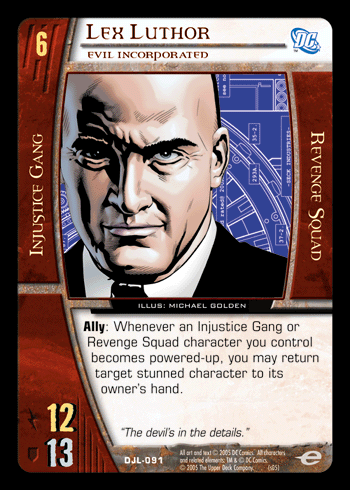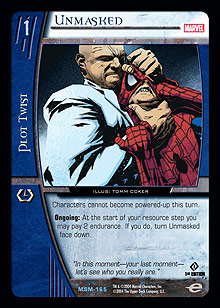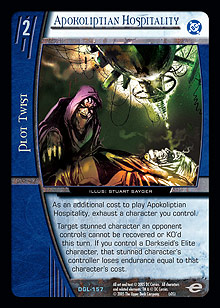
Yes, even a really bad guy can be an ally, though villains like Lex Luthor might have a slightly different take on what it means to help out their teammates. While Superman can provide invulnerability to friends, Lex wipes the opposition off the board. Allies tend to be more concentrated in the heroic teams, but they also have a presence with the villains.
Also, in case there was doubt, it’s not just characters on the JLA team that have dual affiliations. For those of you unfamiliar with the other teams in this set, namely the JLI, Injustice Gang, and Secret Society, there are plenty of opportunities on all of them for dual-affiliated characters. In fact, because we still set aside the typical number of legacy cards solely for previous teams, there’s more than twice as much legacy content in this set compared to previous ones.
Ally
Matt already discussed the rules of ally in his article. In brief, whenever a character you control becomes powered-up, including the one with the ally power, the ally character's power triggers. When you have multiple characters with ally in play, each of their powers will go on the chain with every power-up. As you can imagine, this can lead to some real madness. For example, if Lex and Superman, Avatar of Peace, decided to join forces, a single power-up could both give a character invulnerability and bounce a stunned character. Add to this unlikely pair another ally, and . . . well, hopefully you get the idea. Just imagine all the fun to be had with a board full of allies. Start dusting off those New Teen Titans and cards of similar ilk now.
 Ally will draw new attention to powering-up in our game. We considered many similar mechanics before choosing this one. In some of the alternatives, you would replace the power-up (as with Lost City) or choose only a single ally power. In the end, we went for the most open-ended of these options. Why choose just one option when you can have them all? Then, it was just a matter of giving the set a few ways to deal with cards like Unmasked and including cards and team themes that facilitated powering up.
Ally will draw new attention to powering-up in our game. We considered many similar mechanics before choosing this one. In some of the alternatives, you would replace the power-up (as with Lost City) or choose only a single ally power. In the end, we went for the most open-ended of these options. Why choose just one option when you can have them all? Then, it was just a matter of giving the set a few ways to deal with cards like Unmasked and including cards and team themes that facilitated powering up.
In terms of game play, I think you’ll find that attack order becomes very interesting in decks with ally. While this holds especially true when you have multiple allies, it is evident even when there is a single one, such as Lex. Imagine that you and your opponent each have out a 4-, 5-, and 6-cost character, and it is your initiative. Ideally, you want to stun your opponent’s 6-cost character before Lex becomes stunned so that you can return your opponent’s 6-drop to hand. If you are even more bold, you’d want to do the same to his or her 5-cost character. The problem is that you have to make these attacks and still have an attacker that can be powered-up. Also, you have to figure in the fact that if Lex becomes stunned, you can’t make use of his ally power with later attacks. How to maximize your attack sequence with the best non-stunned allies available during the attacks where you want to power-up becomes very interesting.
If you make the appropriate attacks with Lex and his crew, there’s a good chance that you will send an opponent into the seventh turn of the game without the use of some of his or her best characters. With any luck, you can make such a devastating series of attacks that there will be little your opponent can muster, even with the initiative on turn 7.
On turns when you don’t have the initiative, your opponent must be wary of having any of his or her characters become stunned before stunning Lex. If he or she has a big character with flight, the opponent can always choose to go after Lex first (barring a card like Coast City, but you can set up your formation to take advantage of the fact that the opponent will want to do so.
Hopefully, everyone knows of the power of Finishing Move-like effects, especially when you don’t have to exhaust a character. Admittedly, Lex bounces the stunned character back to your opponent’s hand instead of KO’ing it, but in the end, you’ll find that this is more of a negative for your opponent when playing against the Injustice Gang than you might now believe.
Dual Team Affiliations
Matt discussed a couple of his favorite aspects of dual team–affiliated characters on Friday. One of the most exciting avenues open to us with these cards is the provision of more legacy content without expense to the new teams. Often, our legacy content for some teams is only a few cards or even a single card, especially for the teams from the earliest sets. You might have thought it would be a while before your favorite team could measure up to the forces that rule the day, but your wait may not be as long as you’d anticipated.
 Matt also noted that you are more likely to find some clever uses for our traditional legacy cards in Sealed events. While it might be a stretch to include a card like Death of Superman in your Sealed deck, there are many fun opportunities that arise from other cards. This is particularly true of character cards and non-character cards with both a generic and a team-stamped portion. For example, looking back at the last DC set, cards like Apokoliptian Hospitality and Sensei provide new opportunities in the presence of dual-team characters during Sealed play.
Matt also noted that you are more likely to find some clever uses for our traditional legacy cards in Sealed events. While it might be a stretch to include a card like Death of Superman in your Sealed deck, there are many fun opportunities that arise from other cards. This is particularly true of character cards and non-character cards with both a generic and a team-stamped portion. For example, looking back at the last DC set, cards like Apokoliptian Hospitality and Sensei provide new opportunities in the presence of dual-team characters during Sealed play.
Besides reinvigorating older teams, the dual-affiliated character cards are a convenient jump-start toward the creation of Team-Up decks between their two specific teams. One of the weaknesses of Team-Up decks is apparent when you don’t draw your Team-Up. On the flip side, you can also get poor draws in which you draw your Team-Up but can’t play it because you're only drawing into characters of a single team or you can’t get out characters of both teams early enough to meet your goals. Dual-affiliated characters can help immensely in both of these scenarios. If you don’t draw a Team-Up, you will still be able to target the dual-team characters and use them to pay costs. In the case of having the Team-Up, a dual-team character allows you to flip your Team-Up by itself, even if it is the first character in play. This allows you to gain immediate access to all of your team-stamped cards. These factors make teaming-up much more viable once you consider the fact that there will be multiple dual-team characters between some of the two-team combinations. We’ve also continued the use of our Team-Up keyword to help find and protect cards that band your teams together.
One additional exciting thing about the dual-affiliated characters is that they are privileged in access to a certain group of cards; they don’t need a Team-Up card to take advantage of other cards that specifically require a character to have two or more team affiliations. This applies generally to a couple of cards like Call to Arms and Prismatic Shield, as well as to many other cards that refer to specific teams, like Blown to Pieces. There’s a good chance that you’ll see more cards of this variety in the near future.
So, get ready to use the new teams in the JLA set and your old favorites together!
Tomorrow's Preview: